MusicRadar Verdict
Beatformer isn’t just ‘Drum Buss for the rest of us’, but a brilliant drums-orientated multi-effects processor in its own right.
Pros
- +
Friendly and easy to use.
- +
Sounds fantastic.
- +
Supremely transparent.
- +
Tunable sub bass.
Cons
- -
Potentially restrictive mid/side implementation.
MusicRadar's got your back
Obviously inspired by Ableton’s excellent Drum Buss plugin (introduced with Live 10), Beatformer (VST/AU/AAX) is a ‘one-stop shop’ for applying multiband transient and dynamics shaping, and bass and high-frequency harmonic generation to full drum tracks.
A dozen processors are at work in the background, comprising transient shapers, saturators, a compressor and a bass booster, but everything is boiled down to just four knobs at the front, keeping things eminently simple. The two pertinent questions, then, are: does the lack of detailed control over the underlying modules matter, and is Beatformer as sonically effective as Drum Buss?
Punch drunk
Immediately after the Input Gain circuit (+/-24dB), the signal is divided behind the scenes into its low, mid and high components, each of which is sent to its own processing chain, as illustrated in the manual. Only the mid/high crossover is adjustable, via the High Split knob, which positions it anywhere from 4-12kHz. This ultimately sets the frequency divide between Beatformer‘s Punch/Squash and Air processes.
Punch and Squash are closely related, the first altering the balance of the transient and sustain elements of the signal, the second compressing or expanding the resulting output. Both are bidirectional, so you can bring out the transients to add, well, punch or push them back to soften a beat; then add ‘tail’ and smear to the groove by raising Squash, or ‘dry out’ the drums by lowering it. Punch and Squash only operate on the frequencies below the High Split setting.
Above High Split, the Air knob governs the activity of a soft saturator and another transient shaper, adding harmonics for an exciter-style effect when turned clockwise, and working rather like a high-pass filter or high-shelf EQ anticlockwise. The High Split separation between Air and the Punch/Squash combo is creatively empowering, enabling snares and hats, for example, to be handled independently.
Like the majority of effects plugins released these days, Beatformer can be switched between left/right and mid/side stereo processing, the latter separating the mono centre signal from the stereo signal.
M/S mode is available to the Punch and Air sections (it wouldn’t make much sense with the Boom processor, as kick drums should always be kept mono), and to avoid adding complexity, Accusonus have set up specific M/S balancing for each, rather than hand control of that over to the user. Punch works mostly on the mid signal, so as to leave reverbs and delays unaffected, while Air is side-focused for a widening effect, with processing ‘bleeding’ into the mid signal beyond a certain point.
It’s an interesting implementation, and one that generally delivers desirable results, although if you ever want to shape the transients of the side signal alone, say, you might be disappointed.
The Boom control adds sub-bass harmonics to the low frequency range, enhancing kick drums, toms and other bottom-heavy percussion. Like Drum Buss, selecting a note name from the menu below the knob (D1-E2) mixes in a synthesised tone at that pitch, for tuning your kick, tom, etc. Unlike with Drum Buss, however, this is optional - you can just take the Harmonics as they are if you prefer.
Finally, an optional output limiter keeps everything under control at the very end of the signal path.
’Former and function
Beatformer sounds truly sublime, with huge range and flexibility to its transient and sustain shaping, smooth bass and top-end enhancement, and impressive transparency even when pushed hard.
To answer our two introductory questions, at no point yet have we found ourselves wishing we could reach further into Beatformer’s algorithms than its four controls allow; and yes, it’s every bit as useful as Drum Buss, but with more of a focus on transient design and low/high harmonics than overt distortion and compression. Plus, of course, you can use Beatformer in any DAW, not just Live. It’s a superb, effortless plugin, capable of imbuing even the dullest of beats with life and energy, or transforming them entirely.
Computer Music magazine is the world’s best selling publication dedicated solely to making great music with your Mac or PC computer. Each issue it brings its lucky readers the best in cutting-edge tutorials, need-to-know, expert software reviews and even all the tools you actually need to make great music today, courtesy of our legendary CM Plugin Suite.
“We were arguing a lot and we were miserable”: How Green Day exceeded expectations with their most ambitious song
"There’s plenty for us guitarists to learn – and ‘less is more’ is the overriding lesson": how to play like George Harrison on The Beatles' Abbey Road
“They didn’t like Prince’s bikini underwear”: Prince’s support sets for the The Rolling Stones in 1981 are remembered as disastrous, but guitarist Dez Dickerson says that the the crowd reaction wasn’t as bad as people think











